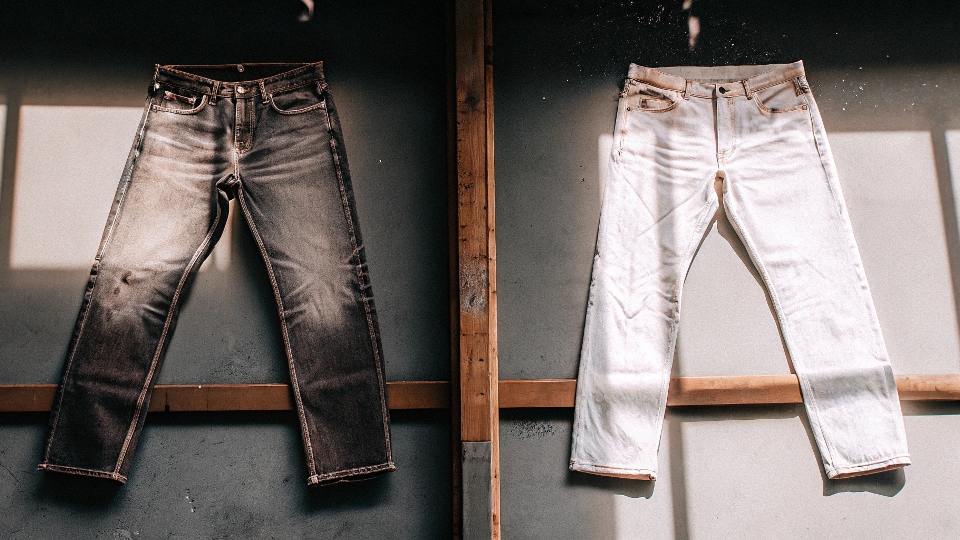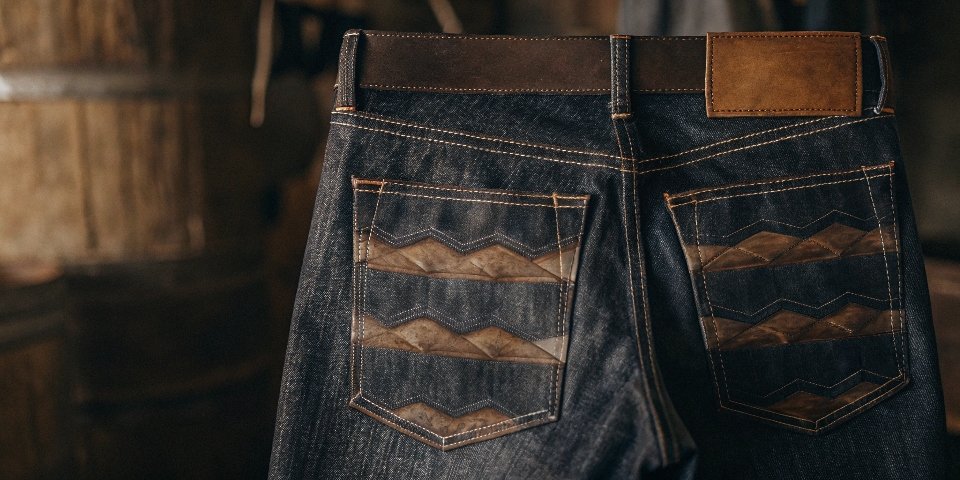You hear denim experts talk about "raw denim" with reverence. But to you, it just looks like very stiff, dark blue jeans. Why should you pay for something that seems unfinished?
Raw denim is denim in its purest, unwashed state. In contrast, regular jeans1 have been industrially washed and treated to be soft and look pre-faded. Raw denim is a blank canvas that you break in yourself, while regular jeans come with a story already written.
Thinking about raw denim takes me right to the factory floor. With "regular" jeans, so much of the work happens after the pants are sewn. We spend hours and a lot of money in the wash house, running them through processes to make them soft and look worn. Your insights are spot-on.
We use sandpaper, lasers, and chemicals to create fades that mimic authenticity. With raw denim, that entire stage is skipped. All the value is poured into the fabric and the construction itself. The final, and most important, step is done by you, the wearer. Let's break down what that really means.
What is the difference between raw denim and jeans?
It seems simple, but the terms are confusing. If all jeans start from denim fabric, what makes a pair "raw" versus just "jeans"?
The simplest difference is water. Raw denim has never been washed or treated. "Jeans" you buy in most stores are finished garments that have been washed to be softer and look broken-in.
In my two decades of making jeans, I've seen the entire process countless times. Imagine two identical pairs of jeans are sewn. One pair goes directly to be packaged and sold. That is raw denim. The second pair goes to the wash house. There, we might subject it to a stone wash, an enzyme wash to soften it, and then hand-sanding to create "whiskers" on the thighs. This second pair becomes a typical "regular" jean.
All that post-production work costs money and labor, as your insight correctly points out. With raw denim, that cost is instead invested in superior fabric and construction from the start. You're not paying for us to destroy the jeans; you're paying for a product built to withstand you destroying them yourself through years of wear.
| Aspect | Raw Denim | Regular (Washed) Jeans |
|---|---|---|
| State at Purchase | Stiff, dark indigo, untreated | Soft, often faded, pre-distressed |
| Feel | Rigid, sometimes compared to cardboard | Soft, comfortable from the first wear |
| Aging Process | Fades based on the wearer's body and life | Fades are artificial and static |
| Cost Driver | Fabric quality & construction | Washing, distressing, & finishing labor |
What is the advantage of raw denim?
Raw denim seems stiff, uncomfortable, and likely to stain your couch. Why would anyone choose this over a soft, ready-to-wear pair of jeans?
The primary advantages are personalization and durability2. Raw denim molds perfectly to your body over time, creates unique fade patterns, and is often made from higher-quality materials that last longer because they haven't been pre-distressed.
Your insights here perfectly capture why denim enthusiasts like my client Dean choose raw denim. It’s about creating something that is uniquely yours.
A Truly Personal Fit and Fade
This is the number one reason. The stiff fabric slowly softens and stretches in places that receive stress, molding to your body like a second skin. As you wear them, the indigo dye chips away in high-friction areas. This creates wear patterns like "whiskers" across your lap and "honeycombs" behind your knees. These fades are a direct map of your life in those jeans. My factory can try to replicate this with lasers and sandpaper, but we can never match the authentic beauty of a naturally worn-in pair.
Better Quality for Your Money
This is the practical advantage. With raw denim, a greater percentage of the price goes toward the actual product. You are paying for unique fabrics—heavyweight selvedge, "slubby" textures with tons of character, or interesting colored wefts—that are rarely used for pre-washed jeans. You are paying for a sturdier construction because the garment is expected to last for years. It hasn't been weakened by harsh industrial washing processes before it even gets to you.
What are the disadvantages of raw denim?
You're ready to buy your first pair, but you've heard some horror stories. Indigo-stained furniture, a painful break-in, and confusing sizing charts can feel very intimidating.
The main disadvantages are the tough break-in period, the potential for indigo dye to rub off on other surfaces ("crocking"), the complex sizing research3 required, and the infrequent washing schedule that may not appeal to everyone.
Being honest about the challenges is important. Your list of cons is a perfect starting guide for any beginner. It's a commitment.
The Break-In and the Bleed
Some raw denim can feel like, as you put it, "crusty sandpaper" for the first few weeks or even months. It takes time for the fabric to soften. During this initial period, you also have to deal with "crocking." This is the excess indigo rubbing off. As you correctly warned, you need to avoid sitting on a white sofa or wearing your best white shoes until the jeans have settled down. This is a real part of the experience.
The Homework and the Hygiene
You can't just grab a pair off the shelf. You need to do research. As your insight mentions, you must know if the fabric is "sanforized" (pre-shrunk) or "unsanforized" (will shrink significantly when washed). You have to measure, read forums, and understand how much a specific fabric will stretch. Then there's the washing.
To get those sharp, high-contrast fades, most people wait months between washes. This can be a huge turn-off if you're used to washing your clothes after every few wears.
Are Levi's jeans raw denim?
Levi's is the original American jean company, so it makes sense to ask. Are their iconic 501s and other styles considered raw denim today?
Most Levi's jeans4 you buy today are not raw; they are pre-washed for softness and comfort. However, the brand still sells its iconic "Shrink-to-Fit" 501 jeans, which are classic, unsanforized raw denim that started it all.
This question gets to the heart of denim's history. Originally, all jeans from all brands, including Levi's, were raw denim5. There was no other way. The whole concept of pre-washing for softness came much later to appeal to a mass market that valued instant comfort over personalization. Today, the vast majority of Levi's products are pre-washed to meet that demand.
However, they honor their history with the "Shrink-to-Fit" 501. This is an unsanforized, raw denim jean. It's the same concept that led to the legend of people sitting in a bathtub wearing their new jeans to get them to shrink and form to their body.
For denim purists, this is the authentic Levi's experience. Additionally, their premium Levi's Vintage Clothing (LVC) line is dedicated to recreating historical Levi's models, and many of these are made from high-quality raw selvedge denim, just like the originals. So yes, you can buy raw Levi's, but you have to know what to look for.
Conclusion
Raw denim differs from regular jeans1 by offering a personal journey. It's an investment in a durable, high-quality garment that you shape and fade yourself, creating a truly unique piece.
-
Learn about the differences between regular jeans and raw denim to understand their unique characteristics. ↩ ↩
-
Understand the factors that contribute to the durability of raw denim compared to pre-washed jeans. ↩
-
Explore tips and resources for understanding sizing in raw denim to ensure a perfect fit. ↩
-
Explore the history of Levi's jeans and find out which styles are classified as raw denim. ↩
-
Explore the essence of raw denim and discover why it's revered by enthusiasts for its unique qualities. ↩











